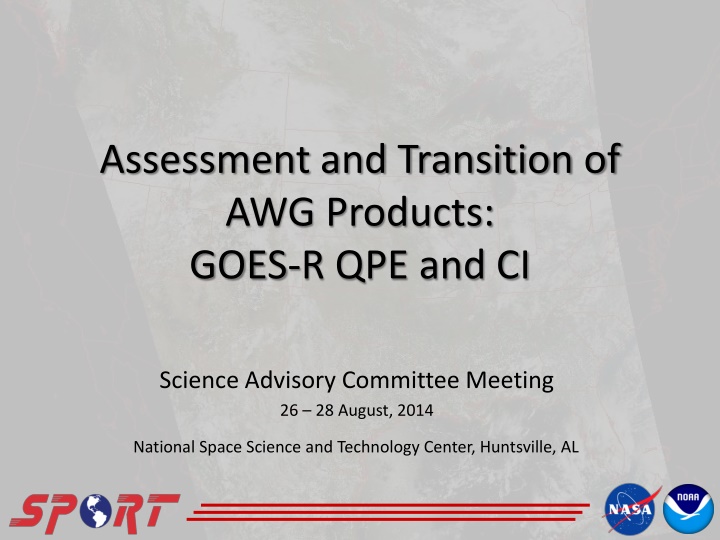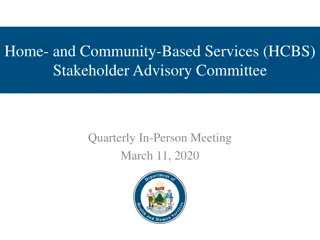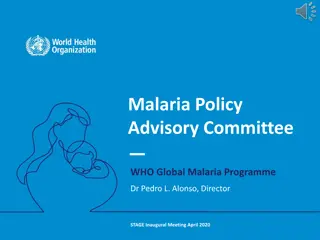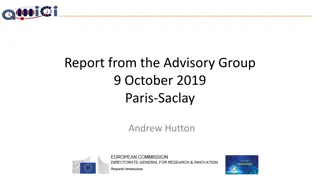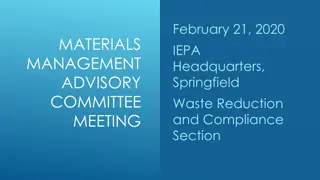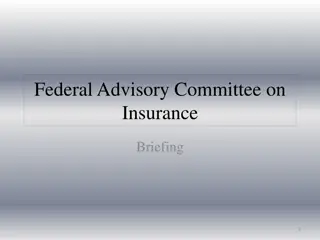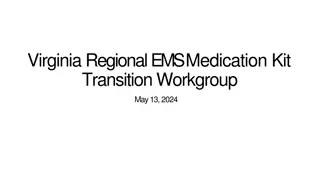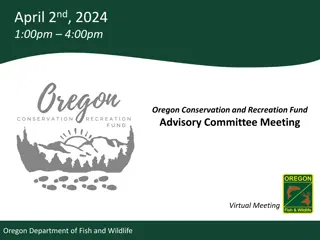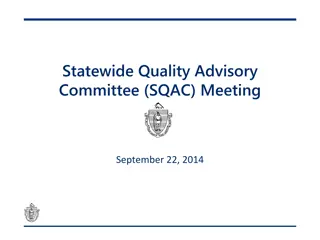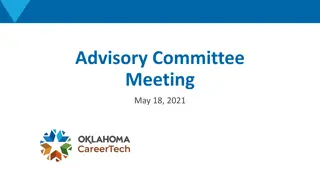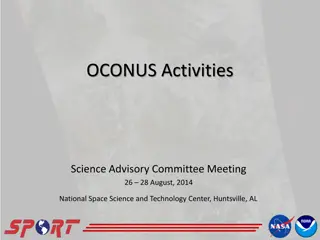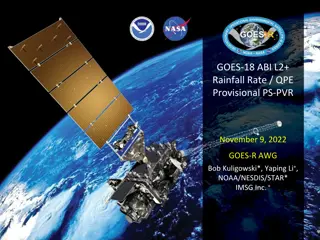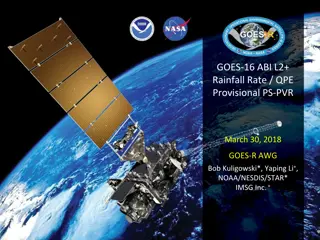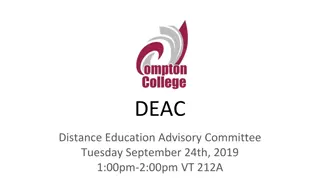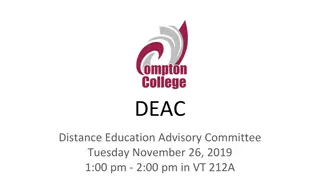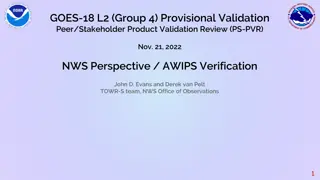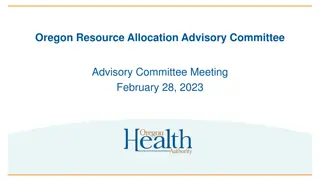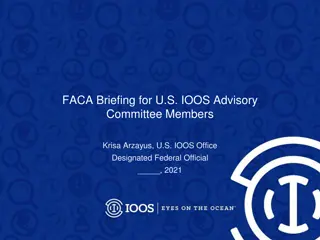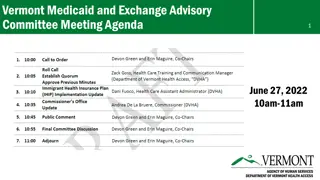Assessment and Transition of AWG Products: GOES-R QPE and CI Science Advisory Committee Meeting
National Space Science and Technology Center in Huntsville, AL hosted a meeting to assess and transition AWG products, particularly focusing on GOES-R QPE and CI. NOAA PG has been actively supporting the transition and training of these products, collaborating with various regions and planning for future enhancements. NASA-SPoRT plays a critical role in transitioning experimental products to operations and ensuring efficient feedback mechanisms. The QPE product aims to address high impact rain events in data-sparse regions using satellite-based rain rate estimates.
Download Presentation

Please find below an Image/Link to download the presentation.
The content on the website is provided AS IS for your information and personal use only. It may not be sold, licensed, or shared on other websites without obtaining consent from the author.If you encounter any issues during the download, it is possible that the publisher has removed the file from their server.
You are allowed to download the files provided on this website for personal or commercial use, subject to the condition that they are used lawfully. All files are the property of their respective owners.
The content on the website is provided AS IS for your information and personal use only. It may not be sold, licensed, or shared on other websites without obtaining consent from the author.
E N D
Presentation Transcript
Assessment and Transition of AWG Products: GOES-R QPE and CI Science Advisory Committee Meeting 26 28 August, 2014 National Space Science and Technology Center, Huntsville, AL
1 NOAA PG Intro AWG Support Where we ve been .. Co-located with UAH developers of official GOES-R Convective Initiation product Support transition (training) of product and user DSS integration Conducted assessment and provided feedback to developers Collaborated with QPE AWG to transition and assess product West Coast, Alaska, and Puerto Rico What we re doing . Continuing to make Convective Initiation product available to WFOs and NCs Collaborating with Pacific Region for QPE Assessment in Fall 2014 Planning with QPE developers for eventual use of Himawari version of product Participating in Air Quality AWG transition planning
Why NASA-SPoRT Transitions and Assesses AWG Products Is a leader in transitioning experimental products to operations Has a proven paradigm for training, transitioning, and assessing experimental products Recall SPoRT Assessment Paradigm aims to: Provide efficient and effective forum for forecasters feedback Gather detailed, actionable information for product developers, program managers, etc. Assessment Characteristics Does not take the place of AWG-led validation studies 5-point Likert scales Use of/confidence in training, confidence in product, product utility in meeting forecast challenge NESDIS GOES-R QPE: Bob Kulgowski UAH GOES-R CI: John Mecikalski Can work with other AWGs through the PG to transition and assess 2
3 QPE Product and Purpose Forecast challenge: high impact rain events in data- sparse regions (AK, SJU, WC) 90 surveys from a variety of operational cases/conditions GOES-R ABI baseline product Satellite-based rain rate estimates based on IR data calibrated using microwave rain rates Input data: IR channels from GOES Microwave from TRMM TMI, MHS on NOAA 18/19 and METOP-A Current GOES: 4km spatial resolution 15 minute temporal resolution Domains: GOES-East, GOES-West (including AK, HI, and SJU) NESDIS GOES-R QPE
4 GOES-R QPE Training Teletraining Sessions March 6th 2013 and July 9th and 11th, 2013 for WFO SOOs and staff with product developer Bob Kuligowski Region-Specific Quick Guides: CONUS, AK, and SJU/HI Site Visits to AFC, AFG, and AJK in July 2013
5 GOES-R QPE Quantitative Results Terrain- Influenced Convection 25 GOES-R QPE: Underestimates in SJU Overestimates rainfall on the coast and underestimates in the mountains along the WC Performed inconsistently in AK http://weather.msfc.nasa.gov/spo rt/evaluations/ QPE - SJU 20 No. of Responses Stratiform 15 Frontal Boundary 10 Offshore 5 Atmospheric River 1-Hr 0 <-50% -25% 0% 50% >100% 3-Hr Amount of Underestimate/Overestimate Terrain-Influenced 10 4 QPE - AK QPE - WC Terrain-influenced 9 Convection Convective 8 Stratiform 3 No. of Responses No. of Responses 7 Stratiform Frontal Boundary 6 Frontal Boundary Offshore 5 2 Offshore/Incoming Atmospheric River 4 1-Hr Atmospheric River 3 1 2 3-Hr 1-hr 1 6-Hr 3-hr 0 0 24-Hr 6-hr <-50% -25% 0% 50% >100% <-50% -25% 0% 50% >100% 72-Hr Amount of Underestimate/Overestimate 24-hr Amount of Underestimate/Overestimate 168-Hr
6 GOES-R QPE Forecaster Feedback Tstorms over NE PR 15 July 2013 producing moderate flooding Dual-Pol shows ~1in/hr GOES-13 2040-2145 UTC shows warm cloud tops (-49C offshore min) vs 0.5km res DMSP F-16 OLS IR shows overshooting tops (-80C) GOES-R QPE reported trace rainfall Thanks for putting this case together--this is exactly the kind of thing I need to know about. My validation focuses primarily performance and I don't often catch events like these because I'm not looking at everything so close-up. Bob Kuligowski on large-scale
7 CI Product and Purpose GOES-R ABI Future Capabilities high priority Satellite nowcasting for convective initiation Spatial Resolution: 1km on current GOES (4km at night) Temporal Resolution: 15 min Current Domain: GOES-East, GOES-West (CONUS) Input: 9 interest fields from GOES 15 NWP fields from RAP Ground snow cover (SNODAS) Output: Probability of 0-2hr CI GOES: Cloud motion, growth, glaciation, and height + NWP Model: CAPE, CIN, LI = Logistic Regression Little bitty old CI image
8 GOES-R CI Training Teletraining Sessions prior to assessments Quick Guide updated with product changes Articulate Module for self- paced training Site Visits to facilitate collaborations and peer-to- peer training
9 GOES-R CI Quantitative Results Confidence and Impact suggests Positive impact on situational awareness Room for improvement Generally effective lead times Error detected in GOES-West algorithm http://weather.msfc.nasa.gov/spo rt/evaluations/ Rate your confidence in the product's identification of CI 10 5 0 Very Low Confidence Low Medium Confidence High Very High Confidence Confidence Confidence Impact on operational nowcast/forecast process Estimated lead time on 35 dBZ echoes provided by CI 8 5 4 6 3 2 4 1 0 2 0 15 30 45 60+ 0 Minutes Very Small Small Some Large Very Large
10 GOES-R CI Iterative Development 2013: Probabilistic Product (sat+model fields) 2010: Yes/No Product 2011/12: SoS Product Transition Problems: Inconsistently available Forecaster Feedback: Binary output is inaccurate, not very detailed Product Changes: Product available year-round; Strength of Signal Product Forecaster Feedback: SoS MUCH better; lead times improve; no environment Product Changes: new transitions dataflow and process; Probabilistic product includes environment via model data Forecaster Feedback: Better lead times and situational awareness; GOES-West problems
11 In Conclusion SPoRT s core competencies: Transitioning experimental products to end-user DSS Multi-faceted training Robust quantitative assessments SPoRT s role in transitioning and assessing AWGs: Better understand the utility of AWGs in operations Gather vital feedback from forecasters for the development of AWGs
